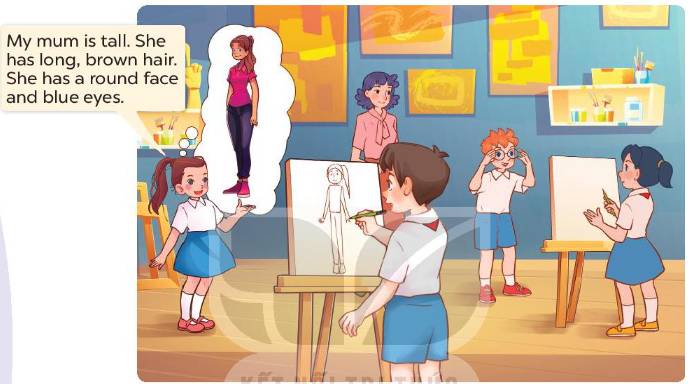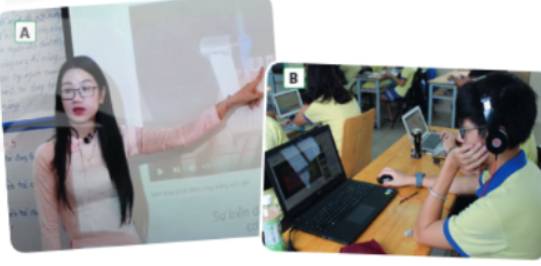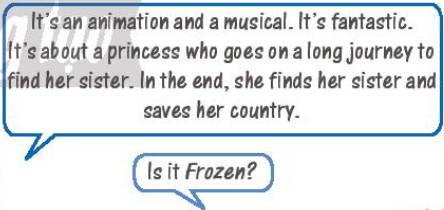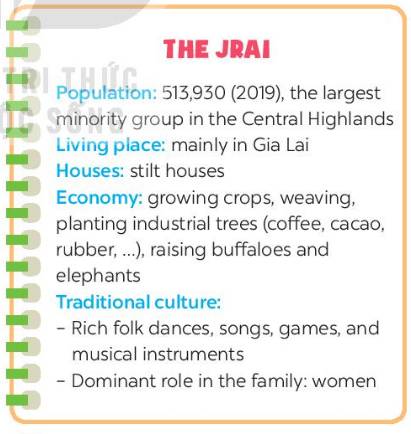Work in pairs. Take turns to describe and draw a family member.

Tuyển Cộng tác viên Hoc24 nhiệm kì 26 tại đây: https://forms.gle/dK3zGK3LHFrgvTkJ6
SPEAKING Work in pairs. Take turns to describe photo B. Include some speculation in your description.

Bài tham khảo
Looking at Photo B, it looks like a classroom environment with one teacher and three students. The teacher appears to be holding some kind of special tool, like solar panels, and is demonstrating it to the students.
The students seem quite engaged and interested in what the teacher is showing them, as one of the students is pointing at the device. It looks like they are discussing the tool and its role in generating renewable energy.
Based on their body language, it looks like the students are actively participating in the discussion and asking questions, which suggests that they are interested in the topic.
Tạm dịch
Nhìn vào Ảnh B, có vẻ như môi trường lớp học với một giáo viên và ba học sinh. Giáo viên dường như đang cầm một loại công cụ đặc biệt nào đó, giống như tấm pin mặt trời, và đang cho học sinh xem.
Các sinh viên có vẻ khá say mê và hứng thú với những gì giáo viên đang cho họ xem, vì một trong số các sinh viên đang chỉ vào thiết bị. Có vẻ như họ đang thảo luận về công cụ này và vai trò của nó trong việc tạo ra năng lượng tái tạo.
Dựa trên ngôn ngữ cơ thể của họ, có vẻ như các sinh viên đang tích cực tham gia vào cuộc thảo luận và đặt câu hỏi, điều này cho thấy rằng họ quan tâm đến chủ đề này.
a. You are talking to a friend about your family. Choose three family members to talk about. Use two adjectives to describe each person and explain why with so and because. In pairs: Take turns asking about family members.
(Em đang nói với một người bạn về gia đình của em. Chọn ba thành viên gia đình để nói về. Sử dụng hai tính từ để mô tả từng người và giải thích tại sao sử dụng so và because. Theo cặp: Lần lượt hỏi về các thành viên trong gia đình của nhau.)

- What's your brother/sister like?
(Anh/chị của bạn như thế nào?)
- He/She's easygoing, so he/she doesn't get angry.
(Anh ấy/cô ấy là người dễ tính, vì vậy anh ấy/cô ấy không tức giận.)
He/She always helps me with my homework because he/she's very intelligent!
(Anh ấy/cô ấy luôn giúp tôi làm bài tập vì anh ấy/cô ấy rất thông minh!)
A: What’s your brother like?
(Anh của bạn như thế nào?)
B: He is helpful because he does my chores with me.
(Anh ấy có ích vì anh ấy làm việc nhà cùng tôi.)
Work in pairs. Take turns to describe and compare the photos. Then ask and answer the following questions.

1 Do you agree that in the modern world, science is a more important subject than languages? Give reasons.
2 Do you think technology sometimes makes it harder for people to communicate with each other? Why?/ Why not?
Mô tả tranh
A: In picture A, a teacher is standing in front of the class and appears to be teaching a lesson
B: Picture B, on the other hand, shows a student working on a laptop wearing headphones in the classroom. It looks like the student is working on an individual task.
A: It's interesting to see how technology is being used in the classroom in both pictures. In picture A, the teacher is likely using a whiteboard or projector to help illustrate their lesson, while in picture B, the student is using a laptop to complete their work.
B: Yes, that's a good point. It seems like technology is becoming more integrated into the classroom, allowing for more individualized learning and different modes of teaching.
A: Another difference is the level of interaction between the teacher and students. In picture A, the teacher is leading the lesson, while in picture B, the student is working independently.
B: That's true. However, it's important to note that both forms of learning and teaching have their advantages and disadvantages, and it ultimately depends on the goals and needs of the students.
(A: Trong hình A, một giáo viên đang đứng trước lớp và có vẻ như đang giảng bài
B: Mặt khác, hình B cho thấy một học sinh đang làm việc trên máy tính xách tay đeo tai nghe trong lớp học. Có vẻ như học sinh đang làm một nhiệm vụ cá nhân.
A: Thật thú vị khi xem cách công nghệ được sử dụng trong lớp học trong cả hai bức tranh. Trong hình A, giáo viên có thể đang sử dụng bảng trắng hoặc máy chiếu để giúp minh họa bài học của họ, trong khi ở hình B, học sinh đang sử dụng máy tính xách tay để hoàn thành bài tập của mình.
B: Vâng, đó là một điểm tốt. Có vẻ như công nghệ đang được tích hợp nhiều hơn vào lớp học, cho phép học tập cá nhân hóa hơn và các phương thức giảng dạy khác nhau.
A: Một điểm khác biệt nữa là mức độ tương tác giữa giáo viên và học sinh. Ở hình A, giáo viên đang dẫn dắt bài học, còn ở hình B, học sinh đang làm việc độc lập.
B: Đúng vậy. Tuy nhiên, điều quan trọng cần lưu ý là cả hai hình thức học tập và giảng dạy đều có những ưu điểm và nhược điểm, và cuối cùng nó phụ thuộc vào mục tiêu và nhu cầu của học sinh.)
Bài tham khảo trả lời 2 câu hỏi
A: Do you think technology sometimes makes it harder for people to communicate with each other? Why?
B: Yes, technology can sometimes make it harder for people to communicate because it can create misunderstandings, cultural differences, and language barriers. Additionally, technology can also create some places where people only interact with like-minded individuals and ignore diverse perspectives, leading to polarization and division.
A: Do you agree that in the modern world, science is a more important subject than languages? Give reasons.
B: Both science and languages are important subjects in the modern world, and they play different roles. Science helps us understand the natural world, solve problems, and create new technologies, while languages facilitate communication and understanding among people from different cultures and backgrounds. The importance of each subject depends on one's personal and professional goals, interests, and needs.
Tạm dịch
A: Bạn có nghĩ rằng công nghệ đôi khi khiến mọi người khó giao tiếp với nhau hơn không? Tại sao?
B: Đúng vậy, công nghệ đôi khi có thể khiến mọi người khó giao tiếp hơn vì nó có thể tạo ra sự hiểu lầm, khác biệt về văn hóa và rào cản ngôn ngữ. Ngoài ra, công nghệ cũng có thể tạo ra các nơi nơi mà mọi người chỉ tương tác với những cá nhân có cùng chí hướng và bỏ qua các quan điểm đa dạng, dẫn đến sự phân cực và chia rẽ.
A: Bạn có đồng ý rằng trong thế giới hiện đại, khoa học là một môn học quan trọng hơn ngôn ngữ không? Đưa ra lý do.
B: Cả khoa học và ngôn ngữ đều là những môn học quan trọng trong thế giới hiện đại và chúng đóng những vai trò khác nhau. Khoa học giúp chúng ta hiểu thế giới tự nhiên, giải quyết vấn đề và tạo ra công nghệ mới, trong khi ngôn ngữ tạo điều kiện giao tiếp và hiểu biết giữa những người từ các nền văn hóa và nguồn gốc khác nhau. Tầm quan trọng của mỗi môn học phụ thuộc vào mục tiêu, sở thích và nhu cầu cá nhân và nghề nghiệp của mỗi người.
Work in pairs. Take turns to ask and answer the questions in exercise 4. Answer in complete sentences.
1. What are the latest books made?
The latest books are made into cakes.
2. Where are the latest books displayed?
The latest books was displayed at events all over the world.
3. Was series of three books The Hunger Games adapted for film?
Yes, it was. The Hunger Games is a series of three books that was adapted for film.
4. Who was the film made?
It was made by Crystal Watanabe.
5. Are the books eaten?
Yes, they are. The books are eaten.
USE IT! Work in groups. Take turns to describe a famous book or film using the key phrases. Guess other people’s books and films.

It’s a comedy and an animation. It is a popular Japanese animated series that follows the adventures of a robotic cat and his young human friend. It’s really humorous.
Is it Doraemon?
Work in pairs. Read the information below about the Jrai. Take turns to ask and answer about the information.

A: How many population in Jrai?
(Dân số người Gia Rai là bao nhiêu?)
B: It’s 513,930 in 2019.
(513930 người vào năm 2019.)
A: Is Jrai the largest minority group in the Central Highlands?
(Gia Rai có phải là dân tộc thiểu số lớn nhất ở Tây Nguyên không?)
B: Yes, they are.
(Có.)
A: Where is the Jrai living?
(Người Gia Rai sống ở đâu?)
B: They mainly live in Gia Lai.
(Họ sống ở Gia Lai.)
A: What kind of house does Jrai live in?
(Người Gia Rai sống trong những ngôi nhà như thế nào?)
B: They live in stilt house.
(Họ sống trong những ngôi nhà sàn.)
A: Who plays the dominant role in the family?
(Ai đóng vai trò chính trong gia đình?)
B: Women plays the dominant role in the family.
(Người phụ nữ đóng vai trò chính trong gia đình.)
A: What are they traditional culture?
(Văn hóa truyền thống của họ gồm những gì?)
B: They are rich in traditional folk dances, songs, games, and musical instruments.
(Họ giàu các điệu nhảy truyền thống, các bài hát, trò chơi và nhạc cụ truyền thống.)
Tạm dịch:
NGƯỜI GIA RAI
Dân số: 513930 người (năm 2019), là dân tộc thiểu số lớn nhất ở vùng Tây Nguyên
Nơi sống: chủ yếu sống ở Gia Lai
Nơi ở: nhà sàn
Kinh tế: trồng cây lương thực, dệt vải, trồng cây công nghiệp (cà phê, ca cao, cao su, …) chăn nuôi trâu và voi.
Văn hóa truyền thống: Giàu các bài hát, điệu nhảy và các trò chơi, nhạc cụ truyền thống.
Vai trò chủ đạo trong gia đình: người phụ nữ.
Work in pairs. Take turns to do the tasks below.
(Làm việc theo cặp. Thay phiên nhau làm bài tập bên dưới.)
Student A: Describe photo A in detail first, then briefly compare it with photo B.
(Học sinh A: Miêu tả chi tiết bức tranh A rồi so sánh ngắn gọn với bức tranh B.)
Student B: Describe photo B in detail first, then briefly compare it with photo A.
(Học sinh B: Miêu tả chi tiết bức tranh B rồi so sánh ngắn gọn với bức tranh A.)
Discuss this statement together:
(Cùng nhau thảo luận quan điểm sau:)
'It is more important for schools to spend money on teaching materials than extra-curricular activities'.
(Các trường chi tiền vào tư liệu dạy học thì quan trọng hơn là chi tiền vào các hoạt động ngoại khóa.)
Do you agree? Why?/ Why not?
(Bạn đồng ý hay không? Tại sao.)
Photo A:
This is the background of a music room.
(Đây là khung cảnh của phòng âm nhạc.)
In the central, there are student and teacher.
(Ở giữa có học sinh và giáo viên.)
The photo shows teacher teaching student to play violin.
(Bức ảnh cho thấy giáo viên dạy học sinh chơi vi-ô-lông)
Photo B:
This is a photo in swimming pool.
(Đây là bức ảnh của một hồ bơi.)
In the central, there are teacher and some students swimming in the pool.
(Ở giữa có giáo viên và các học sinh đang bơi trong hồ.)
The photo shows teacher teaching students to swim.
(Bức ảnh cho thấy giáo viên đang dạy học sinh bơi.)
Comparison:
In both photo, we can see students learning the extra-curricular activities which are music and sport.
(Trong hai bức hình, ta thấy các học sinh đang học các hoạt động ngoại khóa như âm nhạc và bơi lội.)
Discussion:
Some people believe that “It is more important for schools to spend on teaching materials than extra-curricular activities”. In my opinion, this point of view is not totally persuaded. Firstly, in the modern era, it is essential for students to develop both academic and social skills. Secondly, extra-curricular activities shouldn't be ignored since they provide children opportunities to discover themselves and their interests. Therefore, schools should balance spending on teaching materials with extra-curricular activities.
(Một số người cho rằng “Việc nhà trường chi tiền cho tư liệu giảng dạy quan trọng hơn chi tiền cho các hoạt động ngoại khóa”. Theo tôi, quan điểm này không hoàn toàn thuyết phục. Thứ nhất, trong thời kỳ hiện đại, học sinh cần phát triển cả kỹ năng học tập và kỹ năng xã hội. Thứ hai, không nên bỏ qua các hoạt động ngoại khóa vì chúng mang lại cho trẻ cơ hội khám phá bản thân và sở thích của chúng. Vì vậy, các trường nên cân đối chi tiêu cho tư liệu giảng dạy và các hoạt động ngoại khóa.)
Work in pairs. Take turns to ask and answer what each person in 3 likes about their shopping place.
1. Mai
2. Nam
3. Alice
Example:
A: What does Nam like about shopping at a convenience store?
B: It saves time.
Tham khảo
Mai: The products are home-grown and home-made. The market goers know one another. They chat happily while selling and buying.
Nam: They are convenient because they are everywhere. You can save time.
Alice: There is a wide range of goods there. Everything is cheaper than at other places.
1. Work in groups of three or four.
2. Take turns talking briefly about your hobbies( Nói về âm nhạc,cụ thể hơn sở thích là Nghe Nhạc)
3. Work together to cut and glue pictures from magazines or draw pictures of your group members' hobbies.
4. Show and describe your collage to the class.